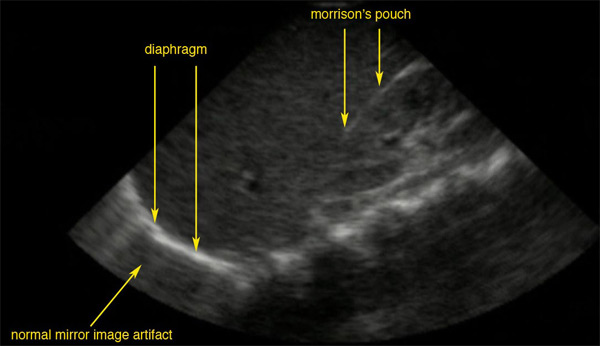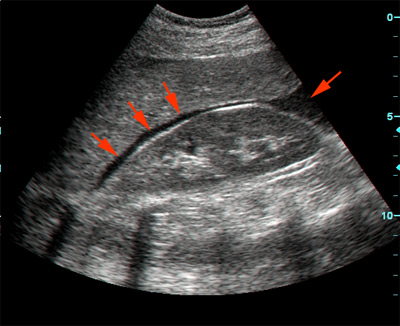Morison's pouch: Difference between revisions
No edit summary |
|||
| (2 intermediate revisions by 2 users not shown) | |||
| Line 4: | Line 4: | ||
==Overview== | ==Overview== | ||
Morison's pouch is the [[eponym]] for the hepato-renal space, named for British [[surgeon]] James R. Morison (1853 - 1939). | Morison's pouch is the [[eponym]] for the hepato-renal space, named for British [[surgeon]] James R. Morison (1853 - 1939). Morison's Pouch is primarily a [[potential space]], meaning that in the state of normal function, there is no separation between the capsules of the [[liver]] and the right [[kidney]]. However, this space becomes significant in conditions in which fluid collects within the abdomen (most commonly, [[ascites]] and [[hemoperitoneum]]). The intra-peritoneal fluid can be blood, [[ascites]], or dialysate, and it collects in this space and may be visualized, most commonly via [[ultrasound]] or [[Computed Tomography]] (CT) scanning. As little as 30 or 40 mL of fluid in the abdominal cavity may be visualized in this space. The medical significance of this space primarily lies in the circumstance of [[hemorrhagic shock]] due to [[hemoperitoneum]]. Early visualization of fluid in Morison's Pouch on FAST Ultrasound is an indication for urgent [[laparotomy]].<ref name="url[Ultrasonic diagnosis of intraperitoneal fluid in M... [J Radiol. 1980] - PubMed - NCBI">{{cite web |url=http://www.ncbi.nlm.nih.gov/sites/entrez?cmd=Retrieve&db=PubMed&list_uids=7392002&dopt=AbstractPlus |title=[Ultrasonic diagnosis of intraperitoneal fluid in M... [J Radiol. 1980] - PubMed - NCBI |format= |work= |accessdate=2013-02-22}}</ref> | ||
Morison's Pouch is primarily a [[potential space]], meaning that in the state of normal function, there is no separation between the capsules of the [[liver]] and the right [[kidney]]. | |||
The intra-peritoneal | |||
The medical significance of this space primarily lies in the circumstance of [[hemorrhagic shock]] due to [[hemoperitoneum]]. Early visualization of fluid in Morison's Pouch on FAST Ultrasound is an indication for urgent [[laparotomy]]. | |||
* A normal ultrasonographic view of Morison's pouch. The bright line is the capsule of the kidney; there is no fluid present and hence no visible space. | * A normal ultrasonographic view of Morison's pouch. The bright line is the capsule of the kidney; there is no fluid present and hence no visible space. | ||
| Line 23: | Line 15: | ||
== References == | == References == | ||
{{Reflist|2}} | |||
[[Category:Anatomy]] | [[Category:Anatomy]] | ||
Latest revision as of 13:36, 22 February 2013
|
WikiDoc Resources for Morison's pouch |
|
Articles |
|---|
|
Most recent articles on Morison's pouch Most cited articles on Morison's pouch |
|
Media |
|
Powerpoint slides on Morison's pouch |
|
Evidence Based Medicine |
|
Clinical Trials |
|
Ongoing Trials on Morison's pouch at Clinical Trials.gov Trial results on Morison's pouch Clinical Trials on Morison's pouch at Google
|
|
Guidelines / Policies / Govt |
|
US National Guidelines Clearinghouse on Morison's pouch NICE Guidance on Morison's pouch
|
|
Books |
|
News |
|
Commentary |
|
Definitions |
|
Patient Resources / Community |
|
Patient resources on Morison's pouch Discussion groups on Morison's pouch Patient Handouts on Morison's pouch Directions to Hospitals Treating Morison's pouch Risk calculators and risk factors for Morison's pouch
|
|
Healthcare Provider Resources |
|
Causes & Risk Factors for Morison's pouch |
|
Continuing Medical Education (CME) |
|
International |
|
|
|
Business |
|
Experimental / Informatics |
Editor-In-Chief: C. Michael Gibson, M.S., M.D. [1]
Overview
Morison's pouch is the eponym for the hepato-renal space, named for British surgeon James R. Morison (1853 - 1939). Morison's Pouch is primarily a potential space, meaning that in the state of normal function, there is no separation between the capsules of the liver and the right kidney. However, this space becomes significant in conditions in which fluid collects within the abdomen (most commonly, ascites and hemoperitoneum). The intra-peritoneal fluid can be blood, ascites, or dialysate, and it collects in this space and may be visualized, most commonly via ultrasound or Computed Tomography (CT) scanning. As little as 30 or 40 mL of fluid in the abdominal cavity may be visualized in this space. The medical significance of this space primarily lies in the circumstance of hemorrhagic shock due to hemoperitoneum. Early visualization of fluid in Morison's Pouch on FAST Ultrasound is an indication for urgent laparotomy.[1]
- A normal ultrasonographic view of Morison's pouch. The bright line is the capsule of the kidney; there is no fluid present and hence no visible space.
- Morison's pouch with fluid present (red arrows).
References
- ↑ "[Ultrasonic diagnosis of intraperitoneal fluid in M... [J Radiol. 1980] - PubMed - NCBI". Retrieved 2013-02-22.

